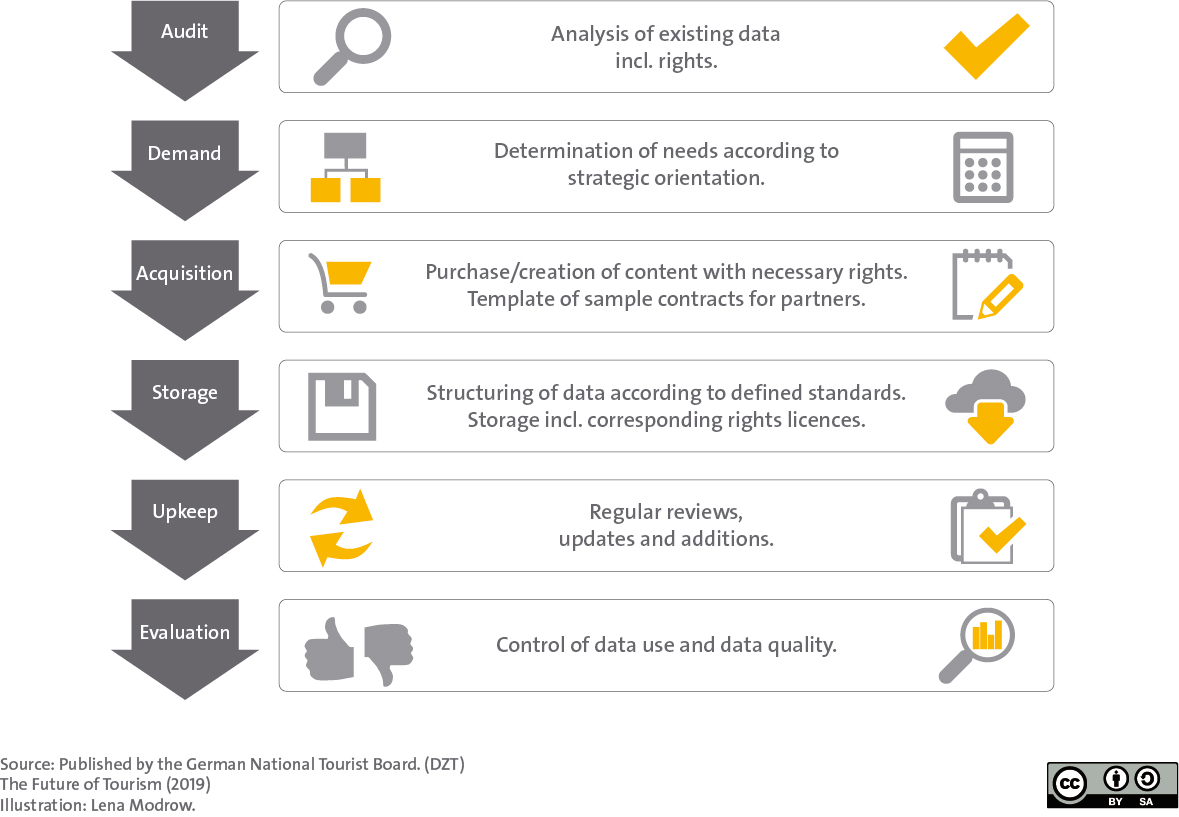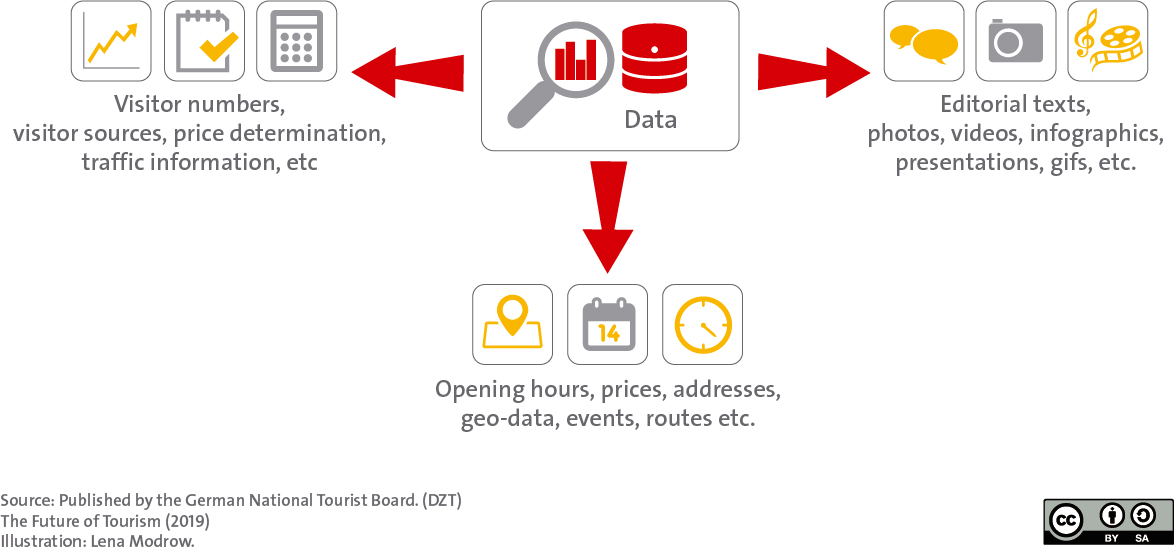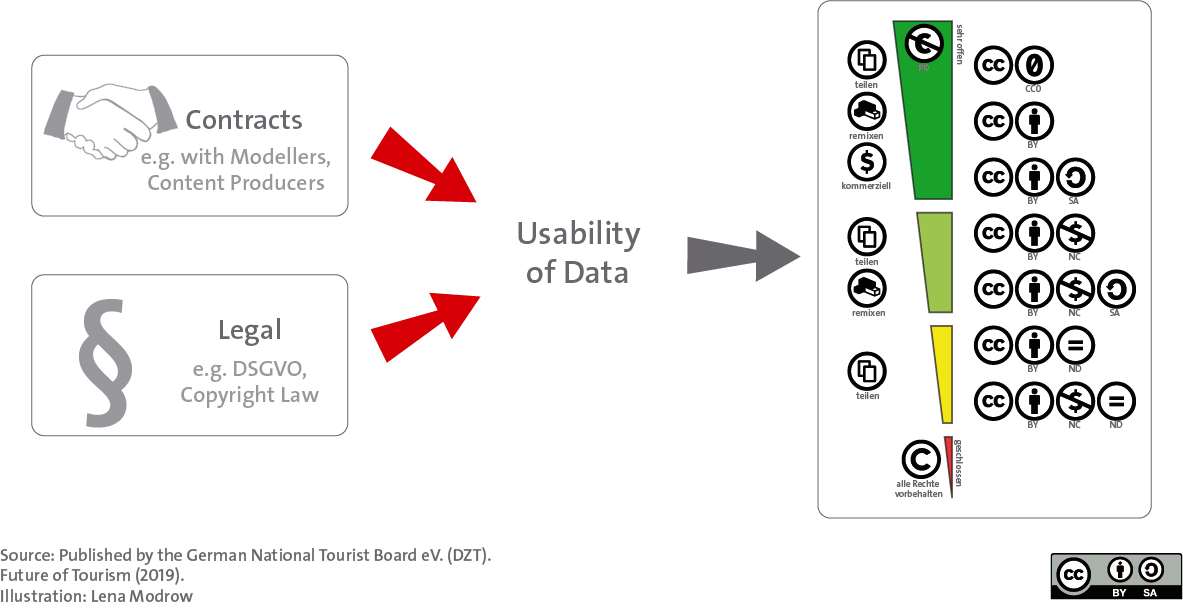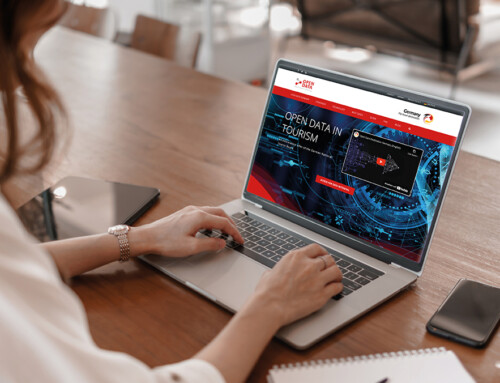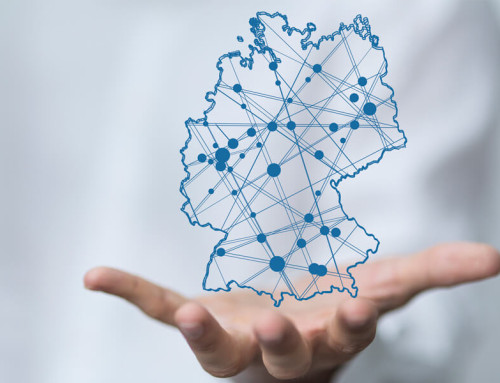Step by step to open data.
Due to digitalization, the tasks of a DMO are changing. DMO once stood for Destination Marketing Organisation, but in recent years this has changed to Destination Management Organisation. If one looks at the now extensive importance of data for the work of a DMO, it becomes clear that the development is moving further towards a data management organisation.
Accordingly, the DMO must accept the tasks associated with this topic for itself and create the necessary conditions for it. But how can Open Data be introduced in an organisation? The individual steps are presented below.
The foundation of Open Data is people
The introduction of Open Data in your own company is not first and foremost about technology, but instead about people.
The DMO must build up appropriate competencies in order to be able to face the new challenges. This includes background knowledge about Open Data: what Open Data means, how it works, what added value it offers the DMO, what impact the introduction of Open Data has on processes and budgets. The decision for Open Data is part of a change process in which existing thought patterns have to change – from “my data” to “data for all”. This requires openness, curiosity and trust. This must be exemplified. Only with leadership in digital topics can persuasion processes be effective.
Openness and mutual trust are not only needed within one’s own team. It is also important to seek solidarity with other tourism organisations and to promote Open Data together with them – also across administrative borders.
A key focus in the implementation of Open Data is to bring the service providers along in the process, as much of the data is collected and maintained by them or created about them. Accordingly, it is necessary to prepare the topic of Open Data for different needs: for the own organisation as well as for different tourism partners. Training courses and personal coaching are just as important as explanatory videos or concrete checklists, such as those provided by the be made available in the course of the knowledge platform Open Data Germany.
Evaluation of the current status: What data do I have?
An audit is used to determine what data is available from the various organisations and companies in the region.
The audit not only determines what content is present, but also …
Not all data already available in organisations can be used as “Open Data”, because not all data may be used, disseminated and reused by everyone for any purpose. Other data, on the other hand, is not worth protecting and can therefore be used freely, such as the opening hours of the swimming pool. A clear legal status of one’s own data is therefore a prerequisite for Open Data. Are they really allowed to be used on all channels? By anyone? Also commercial? And may they also be changed by anyone?
These questions are answered by the existing agreements with content producers such as copywriters, photographers and videographers. In the case of photos and videos, the model contracts and personal rights of the persons depicted also play a role. Rights licenses are used for an appropriate award, which clearly answer the above questions about use.
In general, the usability of content is also influenced by laws such as the German Data Protection Regulation (DSGVO), which regulates the processing of personal data. This applies in particular to data on visitor flows, sales, etc., which are directly linked to the respective persons.
Consolidation of the current status: How do I prepare existing data?
Often data is stored unstructured in the content management system or on the computers of the employees of an organization and is therefore not available for others, often exists several times and is not machine-readable. A common database is necessary so that all data can be stored and maintained centrally in one place.
This database requires uniform standards so that different technologies can read and interpret the data stored there. For this purpose, schema.org or the tourism extension based on schema.org at semantify.it has established itself as the standard, with which POIs or events can be described in a technically clean and machine-readable way.
In order to be able to ensure a high content quality, the standards mentioned must be adhered to as specifications for the maintenance of the data. It is particularly important for later use to store the corresponding usage information directly with the content unit: Who is allowed to use the corresponding data and how?
When content is missing: How do I deal with new data?
For the production or purchase of new content, it is necessary to clarify which data is required in addition to the existing data – based on the company’s own strategy, defined target groups and inspirational topics.
Ideally, newly acquired or produced content should be generated as a total buy-out by default, i.e. with all rights. This should already be taken into account when making arrangements with content producers (e.g. copywriters, photographers, videographers). Sample contracts made available by the DMO provide service providers and producers with certainty of action. In addition to the agreements with content producers, attention must also be paid to the agreements with system operators (databases, CMS, newsletters, etc.) in order to ensure that the data entered can generally be used for other purposes.
As is already the case with inventory data, it is also extremely important to store the corresponding usage information with new data – both in proprietary storage media, e.g. DAM (Digital Asset Management), and in open databases. In principle, the DMO can also impose greater restrictions on the use of the data when publishing it, i.e., for example, it can publish data with a total buy-out only under a different license. This can be useful for key visuals of a campaign, for example.
Data maintenance and data opening: What do I do with my data then?
Data must be consistently maintained, cleansed and supplemented, because only up-to-date and high-quality data is useful. For this purpose, new processes and procedures have to be established in the own organization.
In order to open up data to other organizations and companies, it must not only have the appropriate structure and rights licenses, but must also be made publicly available. One variant for this is the so-called headless web. The idea: All data are schematically marked up on the website (using JSON-LD) and can be crawled there by machines and output context-sensitively elsewhere.
Data can also be entered into the Open Data portals of the regions and countries. And the data must be fed into higher-level systems, for example via the GNTB project on an (inter)national level. With the help of all these ways, data can ultimately be found via Google search or Google’s specific dataset search engine, for example.
Evaluation: What can and should I monitor my data for?
As with all measures, evaluation is essential. To do this, it must be clarified what is to be measured. For this purpose, “data KPIs” are to be developed and stored. These KPIs shall be described and regularly analysed and evaluated. It is important here that the relevant information can also be analysed. Z. For example, usage rights / contract information must be saved with the current status of the contract in order to be able to select all affected content in the event of a legal change.
Key points for evaluation are:
Based on the analysis and evaluation, appropriate measures are to be planned and implemented. These can be budget and personnel shifts, extended training measures, the new acquisition of required data, etc. The measures concern the content itself, the technology, but also the people, because as already written at the beginning, the introduction of Open Data is not primarily about technology, but about people.



